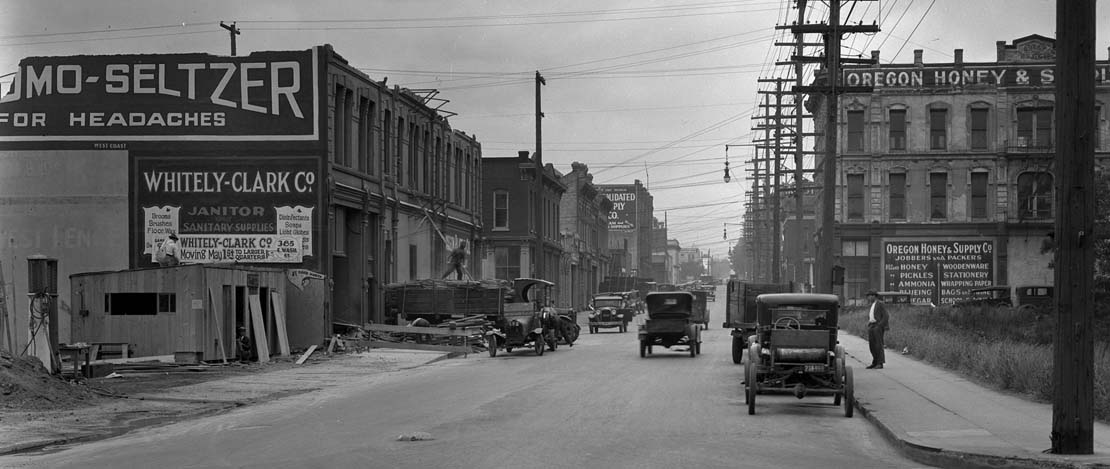
Celebrating the Past
Off to a roaring start

In the year 1921, The Portland Clinic opened its doors to its first patients, and to a rapidly growing and changing city. The Great World War was over, the deadly Spanish flu pandemic was behind us, and the ’20s were beginning to roar. Portlanders, like people all over the country, suddenly found their lives in transition, with exciting innovations such as air travel and commercial radio signaling the modern world’s rush away from the traditional.
Portland was now the 24th largest city in the United States. Over the preceding two decades, its population had nearly tripled, growing from about 90,000 to more than 250,000 as residents traded farm life for life in the city. For the first time, more than half of Oregon’s residents now lived in urban areas.

In those days, most physicians were generalists who ran solo practices. They didn’t have “doctors’ offices.” Oregonians who needed care received it in one of two places: their home or the hospital.
With the ratification of the 19th Amendment the year before, women were exercising their newly won right to vote. Despite prohibition, which Oregon had adopted well ahead of the national law in 1920, young “flappers” were also exercising their right to dance freely in Portland’s popular dance halls. Movie theaters, too, were cropping up all over Portland — so many that, in another first, more Portlanders now were going to the movies than to church on Sundays.
By 1921, more and more residents were leaving the horse and buggy behind and were climbing into their own automobiles. Just a year earlier, the state had enacted its first driving laws, setting a maximum speed of 25 miles per hour. Now, more than 100,000 vehicles were registered in the city. By the end of the decade, one in five Portlanders would own a car.
Soon, air travel and radio would connect Portland with the rest of the country. The city secured land on Swan Island for an airport in 1921, and the following year, Portland tuned into its first radio stations.
Amidst all of these changes, the opening of The Portland Clinic ushered in a major step forward in medical care, as well.
A new idea takes off
In those days, most physicians were generalists who ran solo practices. They didn’t have “doctors’ offices.” Oregonians who needed care received it in one of two places: their home or the hospital.
As Oregon’s first private multi-discipline medical clinic, The Portland Clinic introduced a third option, and a completely new concept, to the region. For most medical needs, it was no longer necessary to go to the hospital or to await the doctor’s arrival on your doorstep. Whatever professional or specialty care you required, it could be provided at the medical clinic.
It was a concept first advanced halfway across the country by two surgeons whose reputations were growing in the Midwest — Drs. Charles and William Mayo. After completing their specialty training, the Mayo brothers joined their father’s family practice in Rochester, Minn., and began inviting other physicians in a variety of disciplines to join them in the group. Soon, the Mayo Clinic revolutionized the idea of cooperative medicine, where clinicians, specialists and laboratory staff all worked together for the good of the patient.
Patients were attracted to this team approach, because it allowed the medical staff to investigate their problems thoroughly, in consultation with each other, and to place them in the care of the specialist who was best able to treat them.
Physicians were attracted to it, as well, with scores of them coming to observe and learn from the Mayo Clinic model. In response, the clinic launched one of the world’s first formal graduate training programs for physicians. One of its first graduates, Thomas Joyce, M.D., headed west, and soon would become a co-founder of The Portland Clinic.
The group comes together
Since the early 1900s, Portland internist Noble Wiley Jones, M.D., had dreamed of forming a multispecialty group similar to the one pioneered by the Mayo Clinic. He shared the idea with three other physicians — Robert Coffey, M.D., Charles Sears, M.D., and Dr. Joyce, who was then completing his surgical training at the Mayo Clinic. All three embraced the concept, and in 1913, they formed a group and began seeing patients. But their efforts were soon interrupted by the United States’ entry into World War I.
After serving in the war, Drs. Jones and Joyce continued their partnership, and others soon joined them. Dr. Joyce invited internist Laurence Selling, M.D., with whom he had served in the war. Dr. Selling invited otolaryngologist Frank Kistner, M.D., and Dr. Kistner suggested ophthalmologist Joseph McCool, M.D.
In June of 1921, the five physicians began their group practice under the name “Jones, Joyce, Kistner, Selling and McCool.” Dr. McCool withdrew soon after, shortening the lengthy name by one, and the four founders of what would later be called The Portland Clinic continued on, building the first physician-owned, multi-specialty group practice in Oregon.
In the ultimate vote of confidence, the Mayo brothers started referring their West Coast patients to the new clinic in Oregon shortly after it opened, rather than having them travel to Rochester. That’s still happening, a century later, as the story of advancing modern medical care continues at The Portland Clinic.